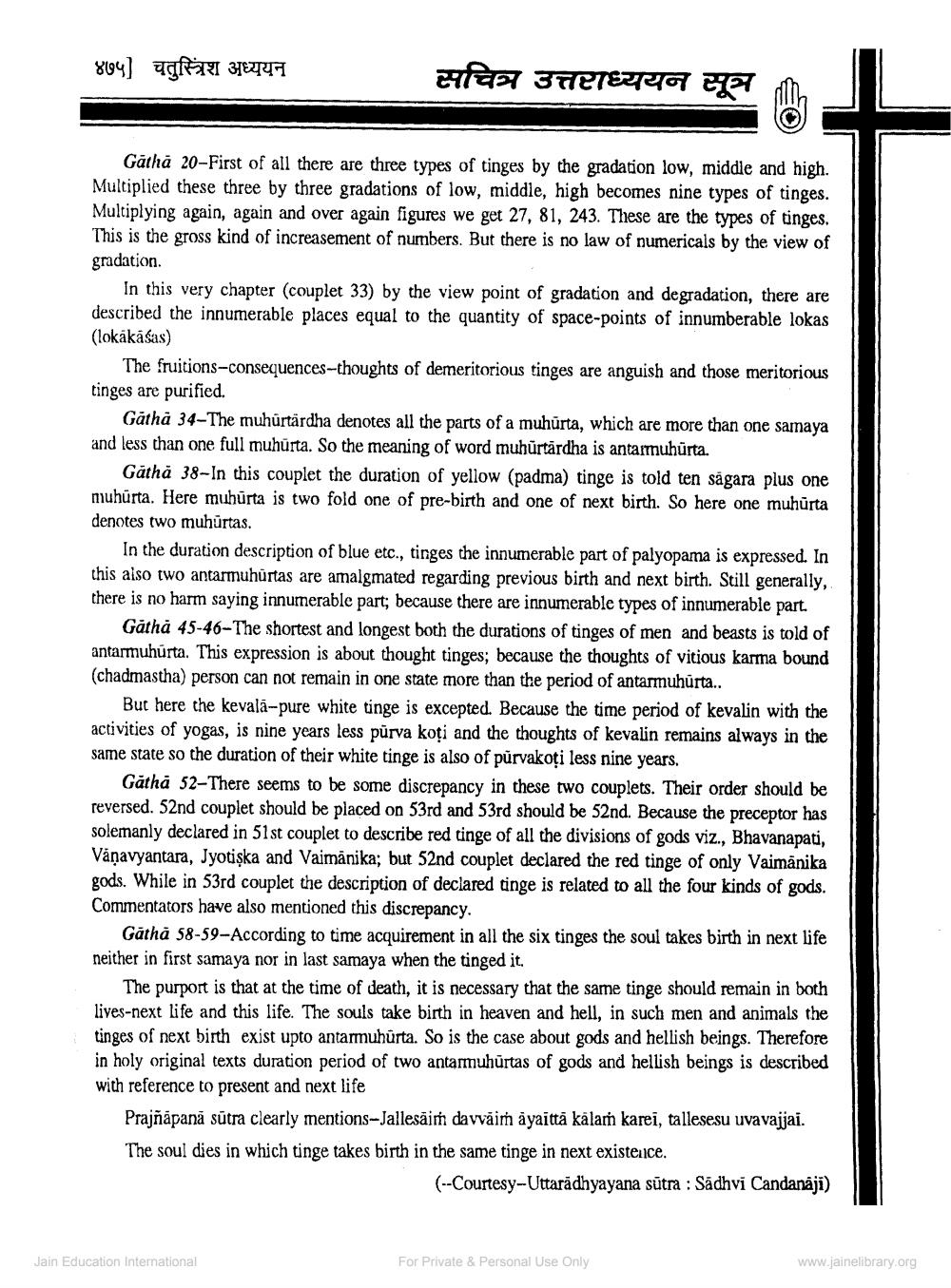________________
४७५] चतुस्त्रिंश अध्ययन
सचित्र उत्तराध्ययन सूत्र
Gātha 20-First of all there are three types of tinges by the gradation low, middle and high. Multiplied these three by three gradations of low, middle, high becomes nine types of tinges. Multiplying again, again and over again figures we get 27, 81, 243. These are the types of tinges. This is the gross kind of increasement of numbers. But there is no law of numericals by the view of gradation
In this very chapter (couplet 33) by the view point of gradation and degradation, there are described the innumerable places equal to the quantity of space-points of innumerable lokas (lokakášas)
The fruitions-consequences--thoughts of demeritorious tinges are anguish and those meritorious tinges are purified.
Gathā 34-The muhúrtärdha denotes all the parts of a muhurta, which are more than one samaya and less than one full muhurta. So the meaning of word muhurtārdha is antamuhurta.
Gatha 38-In this couplet the duration of yellow (padma) tinge is told ten sågara plus one muhurta. Here muhurta is two fold one of pre-birth and one of next birth. So here one muhurta denotes two muhurtas.
In the duration description of blue etc., tinges the innumerable part of palyopama is expressed. In this also two antarmuhurtas are amalgmated regarding previous birth and next birth. Still generally, there is no harm saying innumerable part; because there are innumerable types of innumerable part.
Gåthå 45-46-The shortest and longest both the durations of tinges of men and beasts is told of antarmuhúrta. This expression is about thought tinges; because the thoughts of vitious karma bound (chadmastha) person can not remain in one state more than the period of antarmuhurta..
But here the kevala-pure white tinge is excepted. Because the time period of kevalin with the activities of yogas, is nine years less pūrva koți and the thoughts of kevalin remains always in the same state so the duration of their white tinge is also of purvakoti less nine years.
Gatha 52-There seems to be some discrepancy in these two couplets. Their order should be reversed. 52nd couplet should be placed on 53rd and 53rd should be 52nd. Because the preceptor has solemanly declared in 51st couplet to describe red tinge of all the divisions of gods viz., Bhavanapati, Vāņavyantara, Jyotişka and Vaimānika; but 52nd couplet declared the red tinge of only Vaimānika gods. While in 53rd couplet the description of declared tinge is related to all the four kinds of gods. Commentators have also mentioned this discrepancy.
Gatha 58-59-According to time acquirement in all the six tinges the soul takes birth in next life neither in first samaya nor in last samaya when the tinged it.
The purport is that at the time of death, it is necessary that the same tinge should remain in both lives-next life and this life. The souls take birth in heaven and hell, in such men and animals the tinges of next birth exist upto antarmuhurta. So is the case about gods and hellish beings. Therefore in holy original texts duration period of two antarmuhurtas of gods and hellish beings is described with reference to present and next life
Prajñāpanā sūtra clearly mentions-Jallesaiṁ davvăim ayaitta kälam karei, tallesesu uvavajjai. The soul dies in which tinge takes birth in the same tinge in next existence.
(--Courtesy-Uttaradhyayana sutra : Sadhvi Candanaji)
www.jainelibrary.org
Jain Education International
For Private & Personal Use Only




